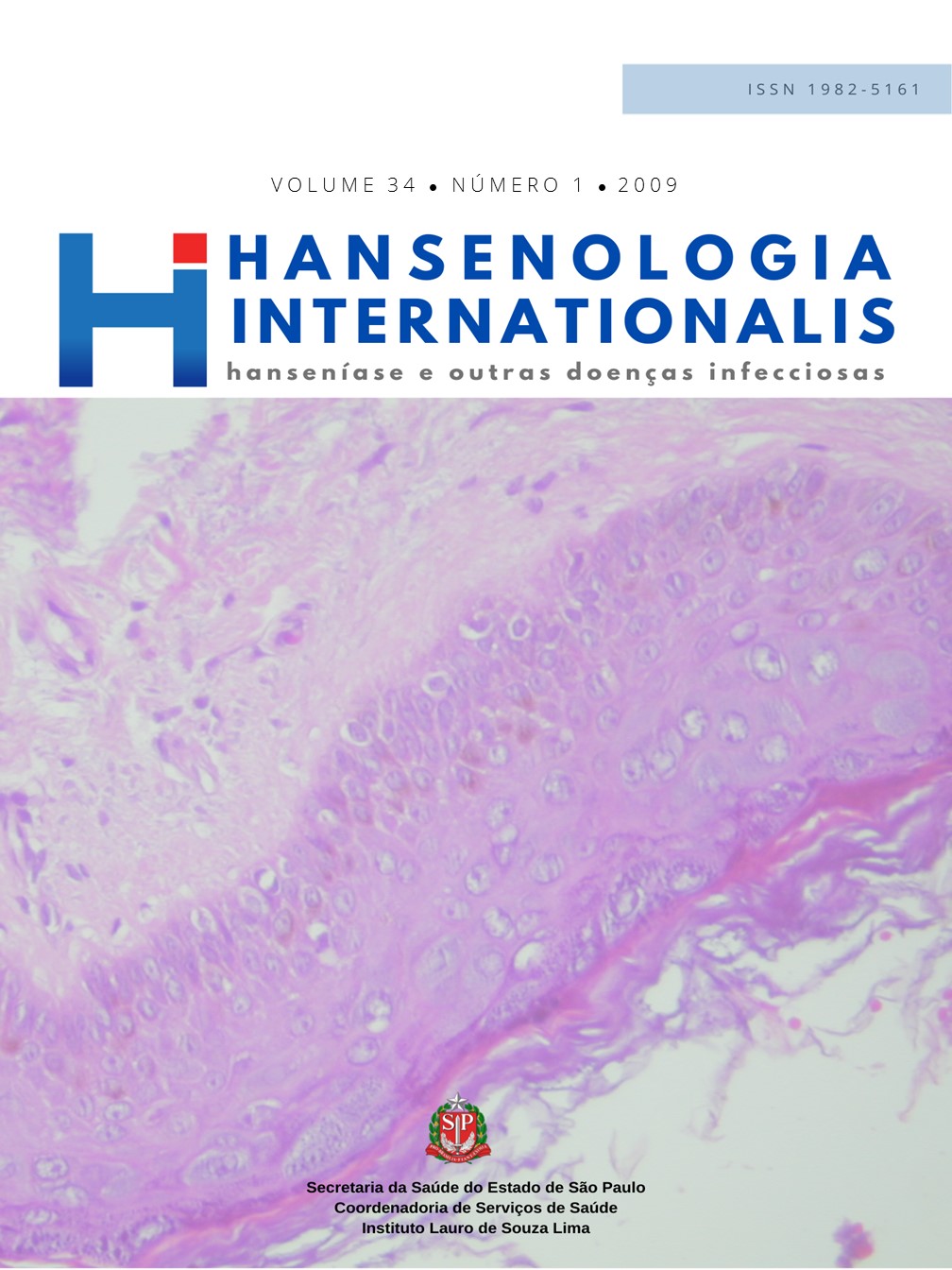Abstract
The multidrugtherapy proposed by the World Health Organization has been effectively implemented in Brazil in 1991. It helped reduce the prevalence and achieve the cure of leprosy. However, its proven efficacy has not prevented the occurrence of relapses in some leprosy patients. Irregular treatment, bacillary persistence or resistance of Mycobacterium leprae to drugs are factors that may be associated with relapse. The objective of this study was assess the occurrence of relapse and associate it with the presence of Mycobacterium leprae resistant strains. In order to do that, 28 individuals who were clinically diagnosed as relapse after treatment with sulphone monotherapy, the National Division of Sanitary Dermatology scheme or multidrugtherapy. Biopsies from lesions of multibacillary patients attended by spontaneous demand were collected to verify
resistance to drugs through the mouse foot pad inoculation technique. Among the samples evaluated 42.8% had bacilli susceptible to dapsone and rifampicin and 10.7% showed resistance to dapsone. No rifampicin resistant bacilli were isolated. The emergence of resistant strains, especially to rifampicin, is a threat to leprosy control programs, therefore, monitoring the spread of these strains is important because resistance pose a serious obstacle to the elimination of disease, particularly in countries where the disease is endemic.
References
2. Andrade V. Implementação da PQT/OMS no Brasil. Hansen Int 2006; 31(1): 23-31.
3. Brasil. Ministério da Saúde. Secretaria de Vigilância em Saúde. Vigilância em saúde: situação epidemiológica da hanseníase no Brasil. Brasília: Ministério da Saúde; 2008.
4. Brasil. Ministério da Saúde. Secretaria de Vigilância em Saúde. Plano nacional de eliminação da hanseníase em nível municipal 2006-2010. Brasília: Ministério da Saúde; 2006.
5. Brasil. Ministério da Saúde. SINAN/SVS/MS. Disponível em: http://www.tabnet.datasus.gov.br
6. World Health Organization. Disponível em:http://www.who.int/lep/research/en/
7. Reddy PK, Cherian A. Relapse in Hansen´s disease after multidrug therapy and its differencial diagnosis with reversal reaction. The Star. 1991. 8-12 .
8. Scollard DM, Smith T, Bhoopat L, Theetranont C, Rangdaeng S, Morens DM. Epidemiologic characteristics of leprosy reactions. Int J Lepr Other Mycobact Dis 1994; 62(4): 559-67.
9. Waters MFR. Distinguishing between relapse and late reversal reaction in multidrug (MDT) treated BT leprosy. Lep Rev. 2001; 72(3): 250-3.
10. Shepard CC. The experimental disease that follows the injection of human leprosy bacilli into foot-pads of mice. J. Exper. Med. 1960; 112: 445-54.
11. Pettit JHS, Rees RJW. Sulfone resistance in leprosy. An experimental and clinical study. Lancet 1964; 2: 673.
12. Matsuoka M, Kashiwabara Y, Namisato M. A Mycobacterium leprae isolate resistant to dapsone, rifampin, ofloxacin and
sparfloxacin. Int J Lepr Other Mycobact Dis. 2000; 68 (4): 452-5.
13. Baohong J. Drug resistence in leprosy – a review. Lepr. Rev. 1985; 56: 265-78.
14. Grosset JH. Study of 39 documented relapses of multibacillary leprosy after treatment with rifampin. Int J Lepr Other
Mycobact Dis. 1989; 57: 607-14.
15. Williams DL, Spring L, Harris E, Roche P, Gillis TP. Dihydropteroate synthase of Mycobacterium leprae and dapsone resistance. Antimicrob. Agents Chemother. 2000; 44 (6):1530-7.
16. Kai M, Matsuoka M, Nakata N, Maeda S, Gidoh M, Maeda Y. Diaminodiphenysulfone resistance of Mycobacterium leprae to mutation in the dihydropteroate synthase gene. FEMS Microbiol Lett. 199; 177(2): 231-5.
17. Honoré N, Cole ST. Molecular basis of rifampin resistance in Mycobacterium leprae. Antimicrob agents chemother 1993; 37: 414-8.
18. Williams DL, Gillis TP. Molecular detection of drug resistance in Mycobacterium leprae. Lep Rev. 2004; 75: 118-30.
19. WHO 1987. Laboratory Techniques for leprosy. Wordl Health Organization, Geneva.
20. Brasil. Ministério da Saúde. Secretaria de Vigilância em Saúde. Guia de Vigilância Epidemiológica. 6 ed.Brasília: Ministério da Saúde; 2005.
21. Kaimal S, Thappa DM. Relapse in leprosy. Indian J Dermatol Venereol Leprol. 2009; 75(2): 126-35.
22. Shetty VP, Wakade AV, Ghati S, Pai VV, Ganapati R, Antia N.H. Viability and drug susceptibility testing of Mycobacterium
leprae using mouse foot pad in 37 relapse cases of leprosy. Int J Lepr Other Mycobact Dis. 2002; 71 (3): 210-7.
23. Maeda S, Matsuoka M, Nakata N, Kai M, Maeda Y, Hashimoto K, et al. Multidrug resistant Mycobacterium leprae from patients with leprosy. Antimicrob agents Chemother 2001; 45(12): 3635-9.
24. Matsuoka M, Budiawan T, Aye KS, Kyaw K, Tan EV, Dela Cruz E, et al. Lepr Rev 2007. 78: 343-52.
25. Matsuoka M, Kashiwabara Y, Liangfen Z, Goto M, Kitajima S. A second case of multidrug-resistant Mycobacterium leprae
isolated from a japanese patient with relapsed lepromatous leprosy. Int. J. Lepr. Other Mycobact. Dis. 2003; 71 (3): 240-3.
26. Zhang L, Namisato M, Matsuoka M. A mutation at códon 516 in the rpoB gene of Mycobacterium leprae confers resistance to rifampin. Int J Lepr Other Mycobact Dis. Other Mycobact. Dis 2004; 72(4): 468-72.
27. Diorio-Madeira S, Manini MIP, Trino LM, Sartori BGC, Opromolla DVA. Resistência a dapsona e rifampicina em Mycobacterium leprae isolado de pacientes portadores de hanseníase no Estado de São Paulo. Hansen int 2005; 30(1): 09-14.
28. World Health Organization. Leprosy Elimination: Research. Disponível em: http://www.who.int/lep/research/en/
29. Gelber RH, Balagon MVF, Cellona RV. The relapse rate in MB leprosy patients treated with 2-years of WHO-MDT is not low. Int. J. Lepr. Other Mycobact. Dis 2004; 72(4): 493-500.
This journal is licensed under a Creative Commons Attribution 4.0 International License.
